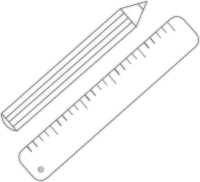Without semantics, design is just an empty shell. Semantics covers the relationship between a sign and its meaning. So, always keep the triangle of meaning in mind.

This triangle shows three players. First, there is the symbol, the smallest entity on a chart. Second, there is the concept or reference. The reference is the concept in our mind. This concept varies. The author most likely has another concept than the user. And third, there is the real thing or process. The symbol just represents it. The same is true for the concept in our minds. It just represents the real thing. So, think twice about how accurate our concepts and symbols are.
From theory to the referent
The designer aims to allow the most adequate interpretation through information design. But it is tricky. Symbols, more often than not, are an abstraction. The word bird does neither look like a bird nor sound like a bird. Language is a technique to bridge the gap between the referent and the symbol. Also, it packs our references into symbols for easy delivery.
Data visualisation is a foreign language for most people
Data visualisation itself is a language. Language is a convention which is limited to people who have learned it. Think about that. A fair amount of your users must learn to interpret your visualisation first. This is especially true for unique visualisations. What’s more, other than the spoken or written language, data visualisation considers human perception a lot more. The reason is it is a vibrant language. It is not limited to just words and pictures. It contains various symbol systems, like animation, interaction, alphanumeric symbols, icons, logos, and even backgrounds, lines, and scales… Hence, data visualisation is complex. If we compare it to spoken and written language, data visualisation is a new communication technique. This is why some people try to unify the language with conventions. This happens also with dialects, where people find a common language. So, it is a good thing.
What makes data even harder to read and write
Data adds another triangle below the symbol itself. Imagine the data does not adequately represent the real thing. As a result, even if we visualise the data perfectly adequately, the visualisation still would not adequately represent the real thing. Perhaps a mistake was made recording the data.
Or take any random chart about the Corona pandemic which compares different countries. Do the numbers speak for themselves? Or what does the data represent? In a country which tests 30% of its population randomly, it is unlikely to find a similar high quote of infected people if we compare it to a country which conducts tests of the 1% of its population who call a doctor because they already have intense symptoms.
To sum up
To sum up, working with data is very challenging. You have to be careful not to fall into a trap. We have a double triangle of meaning, one for the data and its visual representation. As a result, there are four masteries to achieve.
- master the relationship between the referent and the raw data (domain knowledge and a solid methodical background are needed)
- manage the relationship between the raw data and the refined data (data management and documentation skills are required)
- control the relationship between the refined data and its representation (data visualisation skills are needed)
- master the presentation of your visualisation (communication and interaction design skills are required)


